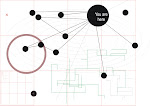Both Patrick Luber and I presented on the curious relationship between art and religion. My presentation simple looking at the theological roots and interests that emerge in my artwork. While Patrick's presentation was more philosophical in nature considering the tenuous history of Christianity's participation in the arts. Despite the divergent approaches to our recent papers, we end up at similar positions that rely upon God's sovereignty to be revealed and use whatever means necessary for God's purposes. I think we would both suggest that a sacramental system allows an intelligent, nuanced, restrained and yet affirming engagement with the material world, and in particular the arts, that sidesteps knee jerk reactions and moralistic judgements.
Unbeknownst to me, a storm of religion and art was brewing 8 hours south of us as a Montana woman drove to Loveland Colorado with intents to destroy a work of art that had been challenged as inappropriate, smut, blasphemous and all the other basic descriptions that many religious folk use to denounce provocative pieces that deal with religion. The Denver Post has been covering the story with some basic articles which you can read here, here, here, and if you look to the right of each article there are links to more articles.
Violent actions toward art is nothing new as the one article recalls, which includes a very long history of religious destruction of work by both Christians and other religious traditions (the articles point out recent examples by the Taliban). Perhaps it is my personality, perhaps my education, perhaps it is my love of the arts, perhaps it is my love of learning and trying to understand others has perhaps given me a higher tolerance for engaging cultural forms. Perhaps. Whatever it is, I am drawn toward understanding these experiences, and trying to better articulate a Christian response.
One of the more curious aspects to this story is the difference between the methodologies of action between the woman who reacted violently by destroying the work with that of the Catholic deacon who arranged a peaceful protest and was heartbroken in the aftermath of the violence. Which, if any is the appropriate Christian action?
Why the knee jerk reactions? I am always puzzled at how quickly we respond with moral rejections of work without knowing context or meaning. What is the artist trying to say? What experiences are behind this work of art? Is their comment valid? Does the church need to hear their voice? These are some of the first questions we should be asking. Once we have come to understand the work of art in question, then, and only then, can we offer a Christian response and further engagement.
This has gotten to be a long post...more thoughts to come







